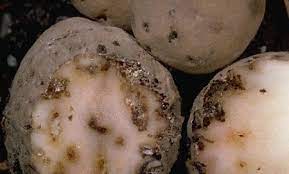
The potato moth (PhthorimaeaoperculellaZell) is a highly specialized pest that damages both cultivated and wild nightshade plants. Tobacco and potatoes are especially affected by it. But the caterpillar of the moth does not refuse to eat the fruits of tomatoes or eggplants and works its way through them, like a worm in an apple.
Biology.
It reproduces both in the field and in warm storages. In the south, it forms 4-5 generations. The duration of development of one generation depends on the temperature (20-60 days):
At a temperature of 22-26C – 28-30 days;
18-20 C – 47 days;
12-15C – up to 119 days.
They fly for 1-2 hours at dawn and after sunset.
During the day, they sit on the underside of leaves.
A butterfly can live up to three or more weeks. The female lays eggs a day after mating on leaves, petioles, stems, uncovered tubers, in the soil in the field, in storage – in cracks, in places of mechanical damage up to 300 eggs.
Caterpillars move in search of food and begin to weave a small web for hiding before mining begins. Eating the parenchyma, they form mines in the leaves and stems, which connect small leaves with a web.
During the drying period of the tops, the larvae move to the tubers, penetrating them through the holes, especially those located near the soil surface. In the future, they live inside the passages, clogging them with excrement.
The development of the caterpillar lasts 11-14 days, during which time it molts 4 times. Caterpillars can tolerate different temperature fluctuations. Having completed feeding and development, they leave the tubers and leaves and weave an inconspicuous cocoon in hidden places.
After 3-4 days, they turn into a pupa. This stage lasts 7-12 days.
During the growing season, the main reservoirs of the potato moth are weeds – common dorsum, black nightshade.
Morphological features.
The potato moth butterfly is quite small, with a wingspan of 1.2 – 1.6 cm. The front wings are gray-brown with yellow scales and brown strokes. Back – with fringe and retracted outer edges. Eggs are oval, up to 0.8 mm long, white, yellow or orange – depending on the stage of development. Eggs develop from three days to two weeks.
The caterpillars are naked, with small bristles, reaching a length of no more than a centimeter. They have a grayish-green or yellowish-pink color with a longitudinal stripe on the back. Brown pupae are covered with a silver cocoon.
Detection.
They install 1 pheromone trap per 5 hectares, 1 trap per 150 tons of potatoes in the potato storage. They are placed along the edge of the length of the field in a line every 100 m, at a height of 50 cm.
Nature of damage.
The caterpillar eats 1/3 or 1/2 of the parenchyma of the leaf (excrements supported by a web are visible near the entrance hole), make mines, and wrap the leaves with a web. A characteristic sign of damage to potato tubers by caterpillars is the accumulation of excrement on their surface.
The skin of the tuber above them dries up, shrivels, eventually settles, and a noticeable scar forms on it.
Phytosanitary measures.
Potatoes should be returned to the former field no earlier than after 3-4 years. If a pest is detected, fumigation of potato tubers with methyl bromide. In storage, before planting, tubers with signs of damage are sorted and rejected.
Planting is carried out in the optimal early period. The tubers are not allowed to be exposed, the bushes are mounded. Potato tops are mowed and destroyed 5-7 days before they dry out. Weeds of the Solanaceae family should be destroyed.
Excavated tubers are quickly removed from the field, preventing butterflies from laying eggs, destroying damaged potatoes and plant remains. Before placing the products for storage, the tubers are treated with biological preparations.

